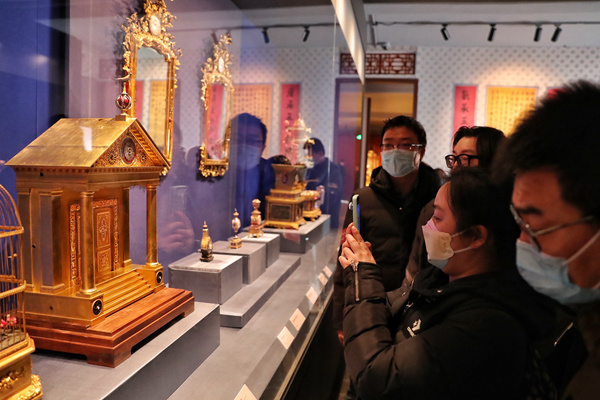The time of emperors
 0 Comment(s)
0 Comment(s) Print
Print E-mail China Daily, February 8, 2022
E-mail China Daily, February 8, 2022
Royal fancy

The ongoing exhibition includes 10 "pairs" of identical timepieces. Some were originally housed in one institution-either the Palace Museum or the Chengde Mountain Resort-while some were "reunited" after being separated for a long time.
"Many European artisans wondered why their clients would order clocks in pairs, as recorded in historical files," Guo says. "They speculated it was because Chinese emperors were rich or farsighted. After one was broken, it could be immediately replaced.
"The misunderstanding shows that China and the West should have known each other better then. In traditional Chinese culture, it's a common saying that good things come in a pair, but such a simple wish turned out to be a puzzle in Europe."
Nevertheless, it is the timepiece that helped to reestablish links between the Chinese royal court and Europe after the decline of the ancient Silk Road as a trade route in the 14th century, says Lou Wei, deputy director of the Palace Museum.
In 1601, Matteo Ricci, an Italian Jesuit, presented two mechanical clocks as gifts to Emperor Wanli of the Ming Dynasty (1368-1644), which then was lukewarm toward communication with the outside world. That successfully hooked the emperor's interest, and the foreign priest was later bestowed an official position in China and started a wave of Sino-Western cultural exchanges.
"They knocked at the door of the Forbidden City and got an answer," Lou says. "With the first two mechanical clocks ever collected by the palace, the nearly 300 years of history of Western timepieces in Chinese royal courts started."
The reign of Qianlong (1736-95) marked the peak of the royal timepiece collection. Following the emperor's passion for fine art, local Chinese studios making mechanical clocks also appeared in Guangzhou, Guangdong province, and Suzhou, Jiangsu province, and some such products that entered the royal collection are also on display in the ongoing exhibition.
Guo says these products feature strong characteristics of local cultures. For example, in Guangzhou, watchmakers preferred shapes of traditional architecture like pavilions and towers, and auspicious totems were often used. In Suzhou, wood clocks in the shape of folding screens were popular.
With the booming scene of watchmaking, the Qing royal court was not satisfied with simply being a collector. The Forbidden City had its own clock workshop during Qianlong's reign to not only fix components, but also make its own products. This period of history also explains why the exhibition is set in the gallery of the Hall of Heavenly Purity. That was where the imperial workshop once was.
The timepieces represent not only the glorious days of the imperial age, but also its decline. When Emperor Guangxu (1871-1908) was under house arrest by the powerful Empress Dowager Cixi, and helplessly witnessed the deep social crisis that led the monarchy toward its end, fixing antique timepieces was probably all the puppet ruler could do to feel the flow of time, according to legend.
New life
This is the second time the timepieces from the Chengde Mountain Resort have left in sets. As the War of Resistance Against Japanese Aggression (1931-45) was approaching, key cultural relics were moved out of the former imperial resort and sent to eastern and western China to avoid being seized by the enemy.
In 1956, after leaving Nanjing, Jiangsu province, the items returned to Chengde. Though the aging timepieces were in need of a comprehensive restoration by then, the lack of restorers postponed the project until recently.
Since 2018, Qi Haonan, a restorer at the museum, and his tutor Wang Jin have led a comprehensive restoration of timepieces at the mountain resort.
"We have solved the same problems in the Forbidden City that we found in Chengde," Qi recalls. "But structures of some mechanical pieces are very complicated. You cannot run against the clock when fixing a clock."
Patience is all they needed. A joint laboratory for antique timepiece restoration was officially set up by the two institutions in 2020, with seven restorers in the team.
"But we can only repair a few large pieces a year to ensure quality," Qi says.
More than 20 timepieces at the mountain resort have been fixed, and the ongoing exhibition is also a demonstration of the team's achievements in recent years. Qi says their goal is to finish checking dozens of other timepieces in Chengde.
The technique used in the restoration of the antique timepieces at the Palace Museum was listed as a national-level intangible cultural heritage in 2014, but Qi and Wang used to be the only regular restorers at the museum.
An online documentary on the restoration of cultural relics in 2016 changed everything. The praise for Masters in the Forbidden City made Wang a celebrity overnight, and since then, numerous young people have applied for the once lesser-known position.
The seven restorers at the Palace Museum are lending a helping hand to institutions nationwide in keeping the former royal timepieces running, and more local restorers are being trained for the future.
"Accidentally or not, we have a growing team and I also have my own apprentices now," Qi says. "More items are displayed after being 'cured', and their charm can be continuously admired."






Go to Forum >>0 Comment(s)